Hawaii is made up of eight islands sitting right in the middle of the Pacific Ocean. It’s the most isolated chain of islands in the world. Now, you may have dreams of green, lush and verdant landscapes teeming with fruit trees, and that image isn’t so far from the truth these days, but it hasn’t always been the case. For most of Hawaii’s history, the islands were barren and devoid of life.
Nearly every tree, bug and animal that you see on the Hawaiian islands has been imported from other parts of the world. The islands were only covered in low-lying bushes with a few native animals before the first Polynesian settlers arrived centuries ago. They brought with them taro, coconut trees, and pigs. And thus began the great importation of plants, animals, and people.
Each island has a section where tropical heat meets humidity. This collision of year-round warmth and moisture is a recipe for life, and most introduced plants begin to thrive in Hawaii. Some plants, like the strawberry guava tree, grow with such vigor that they become invasive, and they begin to threaten other plants on the island.
This outrageous ability for growth allows the Hawaiian islands to produce a myriad of tropical fruits, some of which you may have never heard of. And therein lies the excitement for a Hawaiian vacation. You get to try new things and broaden your horizons.
But where do you find these exotic fruits? And which ones are good? Arm yourself with information so that you have the tastiest vacation possible.
Where To Find Hawaii’s Tropical Fruits
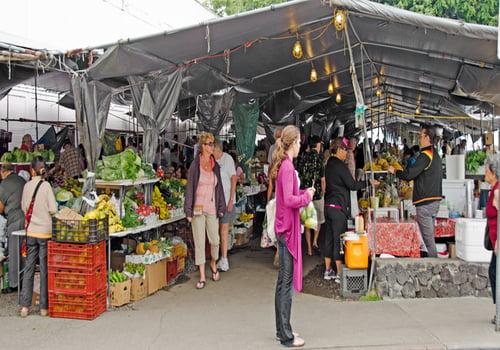 Hawaii’s fruits grow so abundantly that locals share produce with friends, and that produce is simply growing wild in everyone’s backyards. The easiest way to get your hands on some of this wild fruit is at a farmer’s market where locals sell the abundant fruits growing on their properties. They simply cannot eat as much as Hawaii produces.
Hawaii’s fruits grow so abundantly that locals share produce with friends, and that produce is simply growing wild in everyone’s backyards. The easiest way to get your hands on some of this wild fruit is at a farmer’s market where locals sell the abundant fruits growing on their properties. They simply cannot eat as much as Hawaii produces.
Each island has a different schedule of farmer’s markets, but you should be able to find one every day of the week. These farmer’s markets like to change locations on the islands, so you might have to drive a bit to try Hawaii’s incredible fruit. And make sure to arrive early because the best producers often sell out.
You’ll also find plenty of vegetables, nick snacks, jams, jellies and other treats at these markets. You’ll be able to meet the growers, and it’s a great way to make friends. Plus, you’ll be able to sample an abundance of locally grown fruits on the spot to find your favorite. And there’s bound to be fruit that you’ve never seen before.
You can also buy fruit from a farmer’s stand. You’ll find these stands on the side of the road, but you may not find the variety of a farmer’s market. But there’s no bad way to sample Hawaii’s sweet treats. It’s much more delicious than anything you’ll find on the mainland.
The one place you won’t find locally grown fruits is at a chain grocery store. Most of the food sold in these familiar grocery stores has been shipped in from the mainland or other parts of the world. And why would you waste your money on coconut water from Thailand when you can get the fresh stuff cheaper from a local grower?
Coconuts
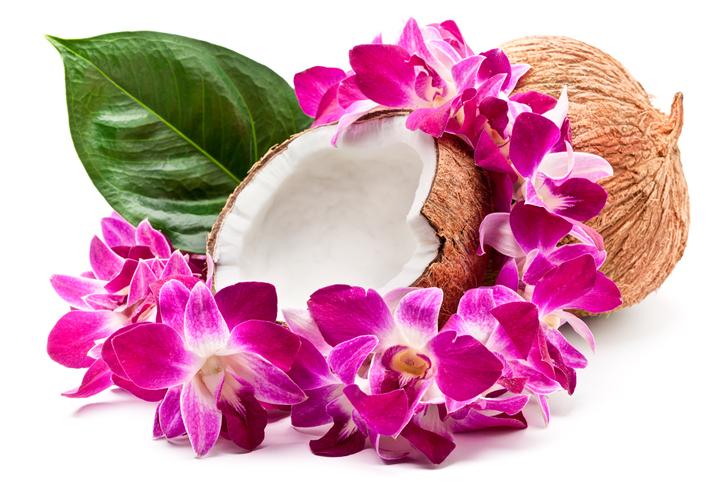 Coconuts grow so abundantly on the islands that you may see park officials climbing the incredibly tall trees using spiked shoes. Once at the top, they lop off the coconuts so they don’t fall on the heads of tourists. The next time you’re near a coconut tree (which will be often in Hawaii), notice the spike-shoe scars in the trunk of the tree. And you might want to keep your distance from any tree without the scars because those coconuts could fall on you at any moment. Never park under a coconut tree with fruit, by the way.
Coconuts grow so abundantly on the islands that you may see park officials climbing the incredibly tall trees using spiked shoes. Once at the top, they lop off the coconuts so they don’t fall on the heads of tourists. The next time you’re near a coconut tree (which will be often in Hawaii), notice the spike-shoe scars in the trunk of the tree. And you might want to keep your distance from any tree without the scars because those coconuts could fall on you at any moment. Never park under a coconut tree with fruit, by the way.
You might also be perplexed when you see a Hawaiian coconut tree. That’s because they look like palm trees. Well, they are palm trees. But the palm trees that you’ve seen on the mainland don’t have any coconuts on them. That’s because those coconut trees have been imported, and the alien climate does not allow them to bear fruit.
Actually, a coconut is not a fruit at all. It’s a nut. That’s why coconuts are so good at making fatty oils for cooking. It’s also why the water and flesh inside the coconut are high in calories. Nuts are notoriously caloric, and coconuts are no exception.
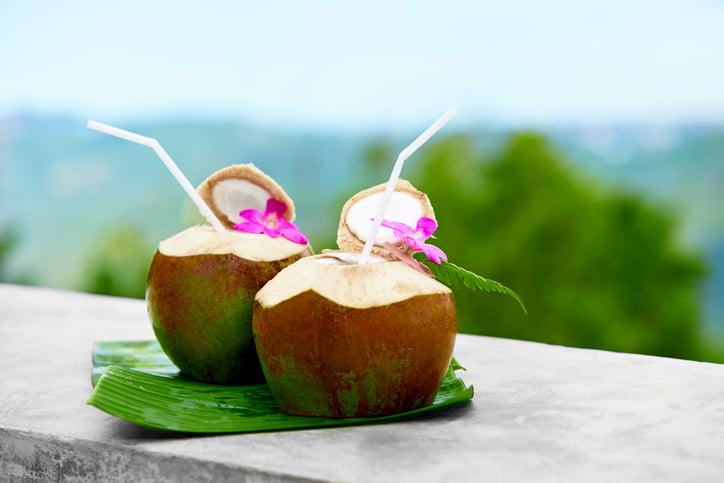 You should absolutely take advantage of Hawaii’s sweet coconuts. The young, green coconuts are full of “water” that is pure, refreshing and full of electrolytes. In fact, coconut water is what Gatorade is attempting to be, but the beverage company uses chemicals and salts while coconut is totally natural. You’ll often find a local selling chilled coconuts at trailheads around the islands. It’s a great way to re-hydrate, and you can even ask the vendor to cut open the coconut so you can eat the flesh after you’re done the drinking.
You should absolutely take advantage of Hawaii’s sweet coconuts. The young, green coconuts are full of “water” that is pure, refreshing and full of electrolytes. In fact, coconut water is what Gatorade is attempting to be, but the beverage company uses chemicals and salts while coconut is totally natural. You’ll often find a local selling chilled coconuts at trailheads around the islands. It’s a great way to re-hydrate, and you can even ask the vendor to cut open the coconut so you can eat the flesh after you’re done the drinking.
Local coconut sellers are masters. They are able to cut open a coconut in seconds while leaving the water and flesh intact. They can also cut you a spoon from the husk so you can scoop the ice cream-like flesh into your mouth without a mess.
The fresh flesh of a Hawaiian coconut is incredibly delicious, and the texture is creamy and velvety. It’s nothing like the coconut shavings you’ll find on the mainland. You may even like it better than ice cream during your Hawaiian vacation, especially if it’s cold.
Longans
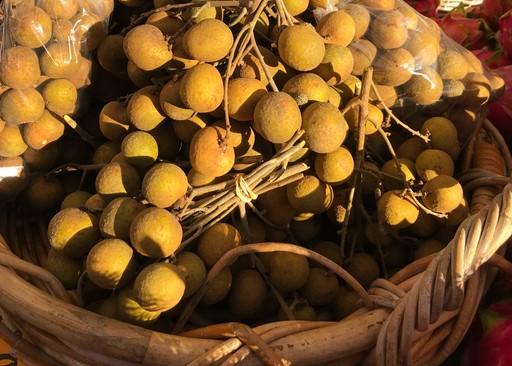 You might overlook this incredibly sweet snack at a farmer’s market, but you should make it a point to try a handful of these grape-sized fruits. Longans have been imported from Asia, and they look unremarkable. They come in bunches, and the fruit’s translucent white flesh is covered in a thick brown skin.
You might overlook this incredibly sweet snack at a farmer’s market, but you should make it a point to try a handful of these grape-sized fruits. Longans have been imported from Asia, and they look unremarkable. They come in bunches, and the fruit’s translucent white flesh is covered in a thick brown skin.
You’ll have to peel the skin to get to the flesh, and there’s no need to be delicate. Stick your thumbnail right into the brown skin and it will crack. This will allow you to quickly peel away the rough covering. Inside, you’ll see what looks like an eyeball. There’s a black pit in the middle of the see-through circular flesh to give you this illusion.
The texture of the flesh is soft, but it does have somebody. It’s not as fibrous as an orange, so it quickly melts in your mouth. The taste resembles lychee crossed with a melon. Just be careful not to bite straight into the rock-hard pit, but the flesh will easily tear away from the pit to give you a mouthful of sweetness.
The great thing about longans is that you can eat them without getting messy. The skin makes for a convenient M&M-like shell. You’ll just have to throw away the shells and the pits after you’re done with the fruit.
Starfruit
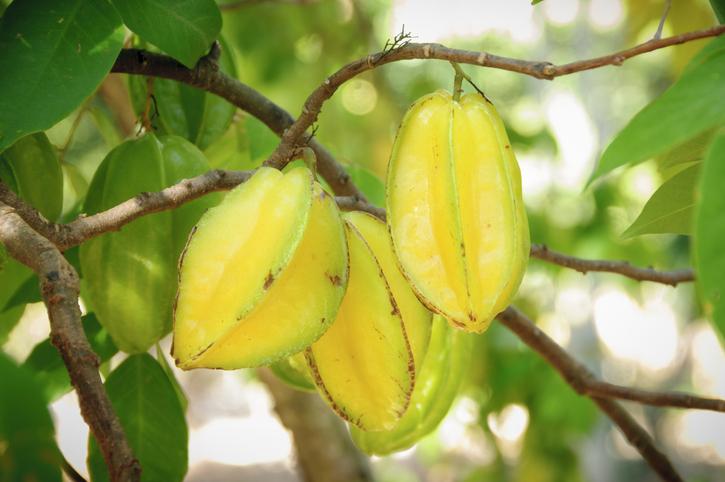 Starfruit grows abundantly in parts of the islands. They hang off of the thin branches of a tall tree, and they’re easy to spot. They glow with a brilliant yellow-orange color that warns you of the fruit’s incredible sweetness.
Starfruit grows abundantly in parts of the islands. They hang off of the thin branches of a tall tree, and they’re easy to spot. They glow with a brilliant yellow-orange color that warns you of the fruit’s incredible sweetness.
Starfruit comes in the shape of a football, but, if you look at the fruit longways, you’ll see the shape of a star. It’s fun to put the football-shaped fruit on a plate to cut it short ways into thin star-shaped pieces.
There are seeds in the fruit, but they are so small that you won’t notice them. A ripe starfruit bites with a crisp. It’s not quite as firm as an apple, but you should hear a similar crunch.
You’ll notice the juiciness right away. Like a watermelon, the fruit fills your mouth with sweet liquid as the flesh melts. You’ll swallow bits of skin and juice with a smile on your face.
Starfruit makes for some of the best juice you’ll have in your life. If you have access to a juicer, buy some fresh fruit at the farmer’s market and you’ll get a massive yield. Otherwise, you’ll have to be lucky enough to walk into a store selling the juice.
Avocado
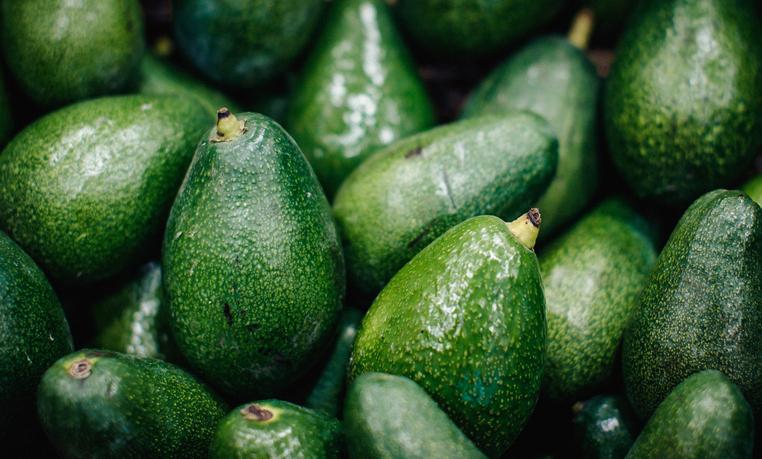 Avocado is rather rare across most of the mainland United States. The hearty fruit grows well in Southern California year-round, but those mainland avocados don’t hold a candle to Hawaiian avo’s. These tropical fruits are huge, sweet and absolutely abundant. In fact, they grow so wild on the islands that you’ll likely be served a side of avo with every meal that you order. On the islands, avocado is not a luxury. It’s an afterthought.
Avocado is rather rare across most of the mainland United States. The hearty fruit grows well in Southern California year-round, but those mainland avocados don’t hold a candle to Hawaiian avo’s. These tropical fruits are huge, sweet and absolutely abundant. In fact, they grow so wild on the islands that you’ll likely be served a side of avo with every meal that you order. On the islands, avocado is not a luxury. It’s an afterthought.
If you’re lucky enough to find an avocado tree, feel free to pick one. They grow so quickly that locals cannot eat enough to keep up. You’ll notice right away that the avocado is huge. Hawaiian avo can be up to four times as large as mainland avocado. And there’s a big difference in the taste, too.
Hawaiian avocado is sweeter and much less salty. It also has a lighter texture and is less dense. It makes for a great mayo substitute, is delicious in salads and is simply irresistible with a little bit of salt and pepper. So, grab yourself a wild avo and you’ll have a topping for sandwiches all week.
Dragon Fruit
 The real name for Dragon Fruit is Pitaya, and, if you’ve been lucky enough to get over to Southeast Asia, then you’ve probably had this tasty fruit for breakfast. The fruit looks stunning. It comes encased in a pink skin that looks like it’s on fire with stylized fins.
The real name for Dragon Fruit is Pitaya, and, if you’ve been lucky enough to get over to Southeast Asia, then you’ve probably had this tasty fruit for breakfast. The fruit looks stunning. It comes encased in a pink skin that looks like it’s on fire with stylized fins.
Cut one of these fruits in half, and you’ll be surprised by the gel-like fleshy insides. The flesh is actually white, which belies the fruit’s colorful exterior. It’s flecked with tiny black seeds, and the taste is fairly mild. Again, the interior betrays the look of the exterior. You’ll find the taste to be a fusion of melon and mild pear.
Egg Fruit
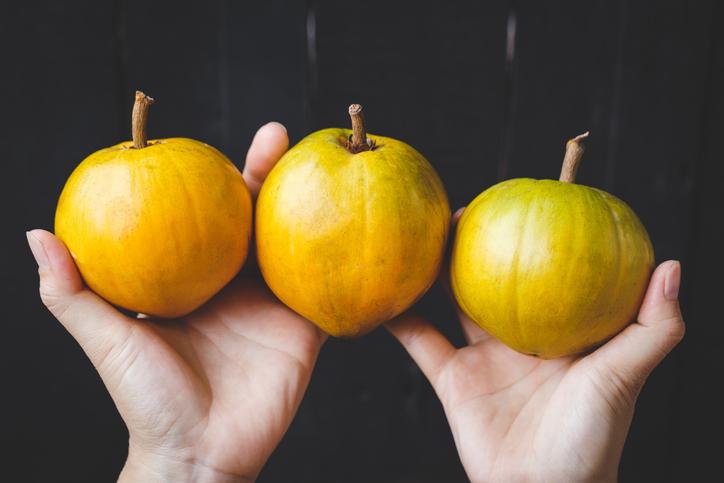 You might miss this rather mundane looking fruit in its rather drab beige-colored skin. These odd fruits hang from a tree, they look like pears and they resemble Valentine’s heart-shape when cutting open. But it’s the texture of the flesh that gives this fruit its name.
You might miss this rather mundane looking fruit in its rather drab beige-colored skin. These odd fruits hang from a tree, they look like pears and they resemble Valentine’s heart-shape when cutting open. But it’s the texture of the flesh that gives this fruit its name.
The flesh feels like a hard-boiled egg yolk, and it looks rather rough when cutting open. The taste of the egg fruit is also quite unique. It’s sweet and savory at the same time, and it resembles the flavor of a pumpkin pie. The egg fruit is an interesting experience. Just don’t expect too much sweetness from this tropical treat.
Noni
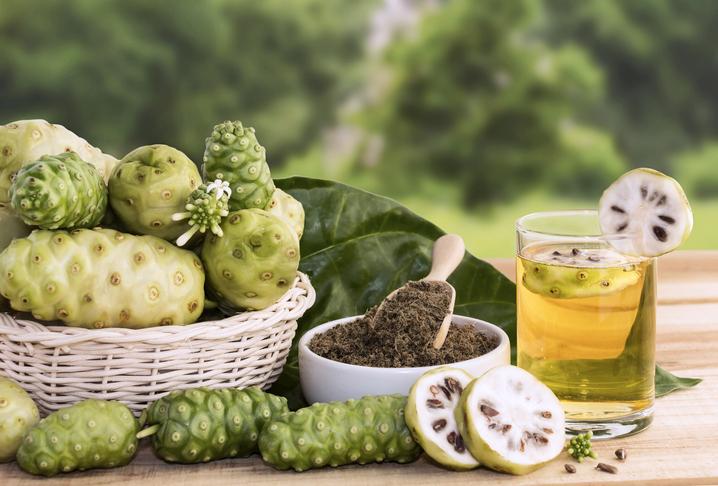 The noni plant made its way to Hawaii from Asia or Australia, and it found a very comfortable home on the islands. The tree loves to live near a volcanic rock, and that’s exactly what Hawaii is made of. But you wouldn’t want to eat this extravagant fruit straight away. It tastes like death.
The noni plant made its way to Hawaii from Asia or Australia, and it found a very comfortable home on the islands. The tree loves to live near a volcanic rock, and that’s exactly what Hawaii is made of. But you wouldn’t want to eat this extravagant fruit straight away. It tastes like death.
So why has it made this list? Because the Ancient Hawaiians believed, and many locals still believe, that the fruit has magical healing powers. In fact, natural healers believe the fruit is capable of relieving ADD/ADHD, addictions, allergies, arthritis, asthma, brain problems, burns, cancer, cardiovascular disease, chemical sensitivity, chronic fatigue, diabetes, digestive problems, endometriosis, fibromyalgia, gout, hypertension, immune deficiency, infection, inflammation, jet lag, multiple sclerosis, muscle and joint pain, polio, rheumatism, severed fingers and sinus pain.
The yellow fruit’s skin is pockmarked with brown spots, and the inside of the pungent fruit features a translucent white flesh dotted with large brown seeds. Crack one open, and you may smell blue cheese or burnt caramel. To temper the flavor, healers like to brew a drink out of the fruit for medicinal purposes, and you may find a bottle or two on sale a local farmer’s market.
Rambutan
 This fruit can look intimidating. The bright red skin of this golf-ball-sized fruit is covered in spiky-looking hairs that scream with yellow accents. The hairs are soft to the touch, and the skin hides a translucent white flesh that’s rather sweet.
This fruit can look intimidating. The bright red skin of this golf-ball-sized fruit is covered in spiky-looking hairs that scream with yellow accents. The hairs are soft to the touch, and the skin hides a translucent white flesh that’s rather sweet.
The skin pops off the shiny white flesh rather easily when cut, and you’ll be able to take the fruit out of the skin whole. It will remind you of longan and lychee because rambutan is in the same family. There’s a hard pit in the middle of the flesh, so be careful when biting into the grape- and cantaloupe-flavored fruit.
Awapuhi
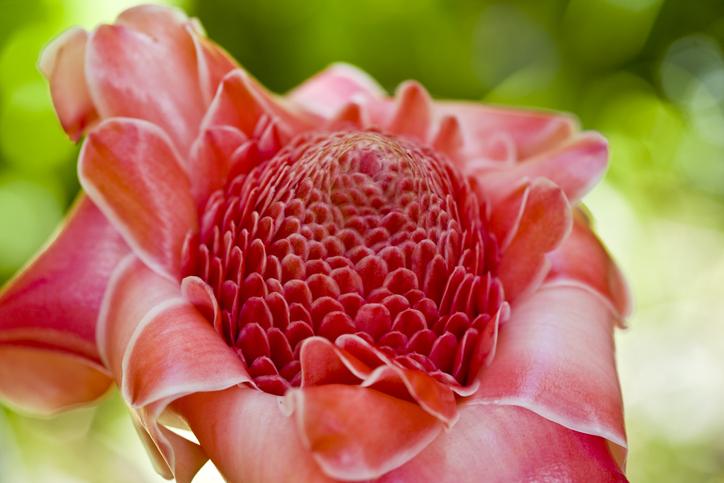 Alright, this one isn’t edible, but it is remarkable nonetheless. You might be lucky enough to find a bulb of awapuhi at a farmer’s market. If not, you’ll have to hunt for the ginger plant in the wild. And the bulb is valuable. It will yield a fragrant soap and shampoo, and it will last for a week in a little bit of water.
Alright, this one isn’t edible, but it is remarkable nonetheless. You might be lucky enough to find a bulb of awapuhi at a farmer’s market. If not, you’ll have to hunt for the ginger plant in the wild. And the bulb is valuable. It will yield a fragrant soap and shampoo, and it will last for a week in a little bit of water.
Take a look at a Paul Mitchell bottle of hair product. You’ll notice a little emblem at the top of the bottle. That’s awapuhi. Just underneath, you’ll read that this is an awapuhi product.
Paul Mitchell made a fortune stealing from native Hawaiian culture. The ancient Hawaiians bathed up to five times per day using this ginger plant, and it’s easy to use. The scaly bulb simply secretes a luscious white soapy liquid when squeezed. So you can pack out a stalk of awapuhi if you find it on a trail in the wild, and it will retain its soap without making a mess.
The bright red bulb grows at the top of a short stalk that stands in the center of a ginger fern. The bulb doesn’t stand much more than 18 inches off the ground. And, when you’re hunting for awapuhi, size matters. The larger bulbs have more soap. Just make sure to respect the islands by only taking one or two bulbs out of the rainforest for your enjoyment.
You can stick the stalk into a glass of water. Keep the bulb in sunlight to keep it alive, or you can just put the bulb right into the shower. Squeeze the bulb, and you have Paul Mitchell-grade shampoo for free.
Poha Berries
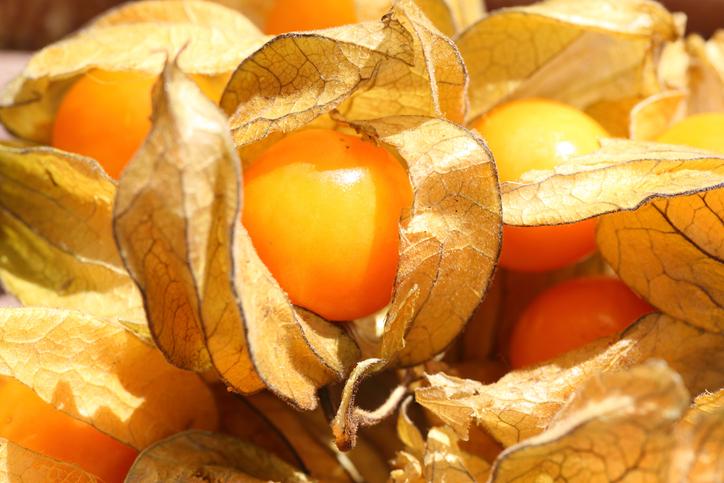 These little yellow berries look like they’ve been individually wrapped in tiny paper lanterns. Peeling off the cream-colored paper is half the fun of eating these mildly tart treats. You’ll notice that they resemble cherry tomatoes, but they are a wildly bright orange-yellow color.
These little yellow berries look like they’ve been individually wrapped in tiny paper lanterns. Peeling off the cream-colored paper is half the fun of eating these mildly tart treats. You’ll notice that they resemble cherry tomatoes, but they are a wildly bright orange-yellow color.
You’ll likely find poha berry jam and jelly if you attend a local farmer’s market. These berries are also great in pies and fruit salads for their mild tart flavor. Just be prepared for the tiny little crunchy seeds when you take a bite.
Cherimoya
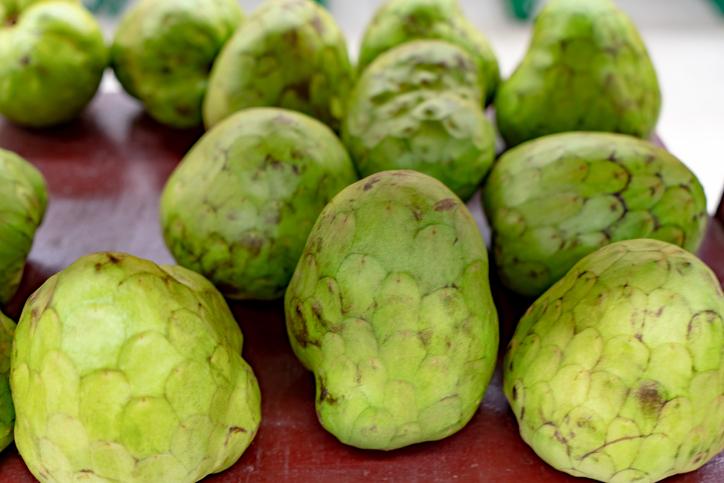 The cherimoya is a funky looking fruit. It’s oddly shaped, about the size of a small coconut and it seemingly has scales. The hard green skin of the cherimoya hides a firm white flesh that is filled with large brown seeds. Cutting into this fruit for the big reveal is half the fun.
The cherimoya is a funky looking fruit. It’s oddly shaped, about the size of a small coconut and it seemingly has scales. The hard green skin of the cherimoya hides a firm white flesh that is filled with large brown seeds. Cutting into this fruit for the big reveal is half the fun.
The cherimoya is often referred to as the custard apple for its creamy texture, and the flavor is absolutely intoxicating. It’s almost like the cherimoya found the most delicious tropical fruits to make a fusion of flavors that includes banana, coconut, strawberry and mango. Some will insist that the flesh tastes like pineapple and papaya. But one thing is for certain -- the cherimoya makes the perfect tropical dessert.
Breadfruit
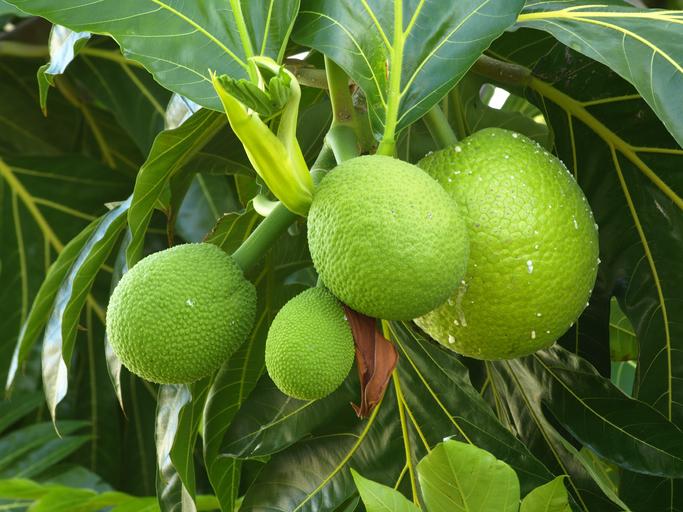 These massive green “fruits” don’t really taste like fruit at all. Instead, the insides of this coconut-sized fruit taste a lot like a white potato. In fact, you’ll probably see breadfruit mash on a tropical menu during your visit to Hawaii. And locals love to saute the potato-like fruit with garlic, olive oil and salt.
These massive green “fruits” don’t really taste like fruit at all. Instead, the insides of this coconut-sized fruit taste a lot like a white potato. In fact, you’ll probably see breadfruit mash on a tropical menu during your visit to Hawaii. And locals love to saute the potato-like fruit with garlic, olive oil and salt.
You might even see breadfruit being used as, well, bread. It makes for a great gluten-free pizza crust, and some wacky restaurants will serve nachos on breadfruit slices. But this is a fruit that you must know how to deal with, so you might be better off leaving it at the farmer’s market, and instead order it prepared at a restaurant.
Lychee
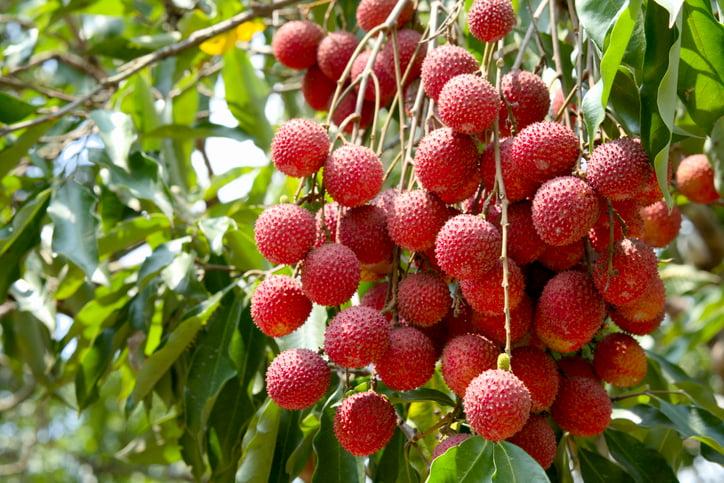 You might mistake lychee for a Hawaiian strawberry. The pink fruit has a similar shape, color, and size to the popular mainland fruit. But a lychee’s skin is hard and inedible. You’ll have to peel this sweet fruit open to enjoy the translucent white flesh.
You might mistake lychee for a Hawaiian strawberry. The pink fruit has a similar shape, color, and size to the popular mainland fruit. But a lychee’s skin is hard and inedible. You’ll have to peel this sweet fruit open to enjoy the translucent white flesh.
The insides of lychee look a lot like the insides of longan or dragon fruit. That’s because they all come from the same family. But lychee’s flavor is probably the sweetest among the three, with a subtle grape- and rose-like flavor. Others insist that the fruit tastes like a fusion of pear and watermelon. But, no matter how you taste the lychee, its a sweet tropical treat not to be missed. And make sure you avoid biting into the hard black pit in the middle of the fruit.
You might as well do the lychee family challenge. Line up a longan, dragon fruit and lychee to see which one is your favorite.
Papaya
 Sure, you can probably walk down to your nearest mainland grocer to buy papaya right now. But the mainland version of this incredible fruit is much less flavorful, so you must try Hawaiian papaya. It’s life-changing.
Sure, you can probably walk down to your nearest mainland grocer to buy papaya right now. But the mainland version of this incredible fruit is much less flavorful, so you must try Hawaiian papaya. It’s life-changing.
You’ll see papaya trees all over the islands. They are tall, skinny and only have leafy branches at the very top. The papayas all grow at the very top as well, and older papaya trees can grow to quite a height.
The green skin of the papaya starts to mature with yellow streaks when it is ripe. The skin is easily cut and keeps its shape to make for a great serving bowl. The fleshy insides of the papaya can be a deep red-orange when fully ripe, and the seeds are easy to handle. All you need to do is scoop them out of the hollow central cavern with a spoon and you’re ready to eat.
The ice cream-like flesh scoops up rather easily, and it tastes a lot like melon but is less sweet. Feel free to sprinkle some lime juice on your papaya, or you can add some peanut butter for a Hawaiian breakfast full of healthy fats and carbohydrates.
Strawberry Guava
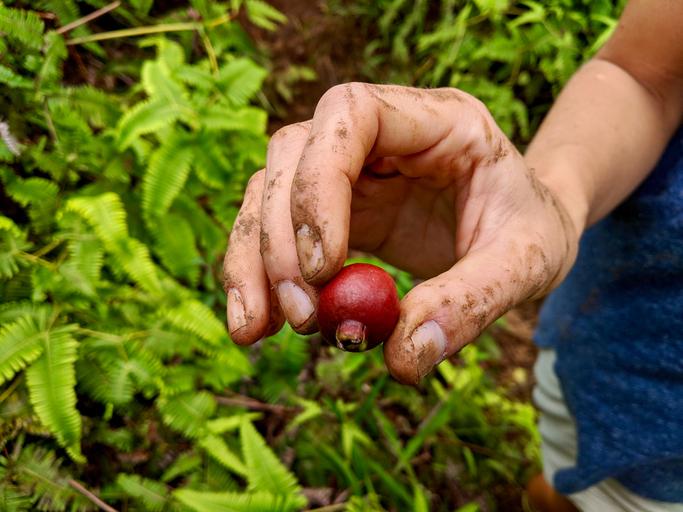 The strawberry guava tree was introduced to the island of Kauai some years ago, and now it has become an invasive species. You’ll often find these trees dropping their fragrant fruits to the ground on the rainforest trails of the Garden Isle. The dropped fruit may smell sweet, but it rots to attracts bugs to the area. The island’s government has even started to pay locals for entering the wilderness to remove some of the trees.
The strawberry guava tree was introduced to the island of Kauai some years ago, and now it has become an invasive species. You’ll often find these trees dropping their fragrant fruits to the ground on the rainforest trails of the Garden Isle. The dropped fruit may smell sweet, but it rots to attracts bugs to the area. The island’s government has even started to pay locals for entering the wilderness to remove some of the trees.
But, if you happen upon a strawberry guava tree and the fruit is within arm’s reach, pluck one. These small yellow-and-orange fruits are a refreshing treat after a long, hot and humid hike. As the name would suggest, they taste just like strawberry mixed with guava. They are easy to crack open, but they can be quite tangy. And you’ll have to deal with a multitude of crunchy little seeds.
Passion Fruit “Lilikoi”
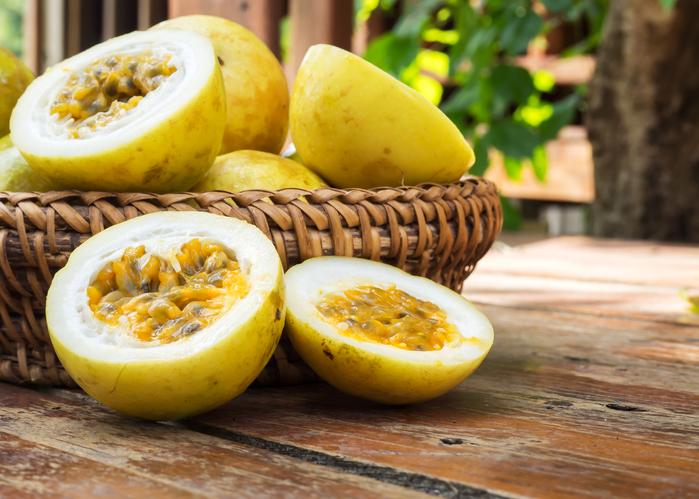 These tiny little fruits crackle with flavor. The hard yellow casing hides a very gooey and fragrant flesh. Crack one of these open, and you’ll see what almost resembles an oyster. The flesh is creamy, shiny and gooey with plenty of little seeds mixed throughout.
These tiny little fruits crackle with flavor. The hard yellow casing hides a very gooey and fragrant flesh. Crack one of these open, and you’ll see what almost resembles an oyster. The flesh is creamy, shiny and gooey with plenty of little seeds mixed throughout.
The fragrance will hit you right away. It makes the air incredibly sweet. And the flavor is intense. It tastes like a mixture of orange and mango, but many find it to be too tart. The lilikoi is often used in mixed juices to enhance the aroma, and its overpowering tart flavor is great for hot weather cocktail.